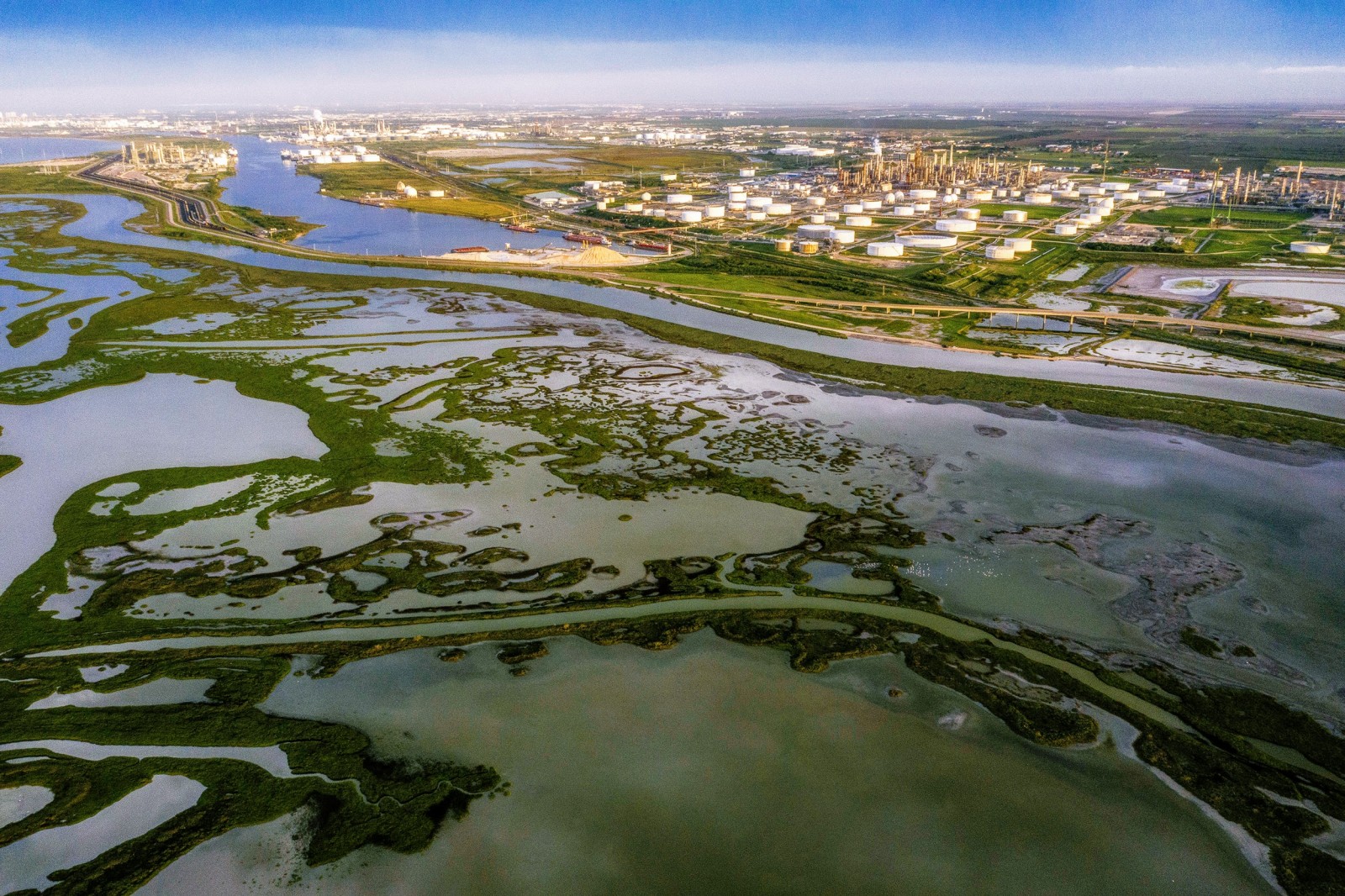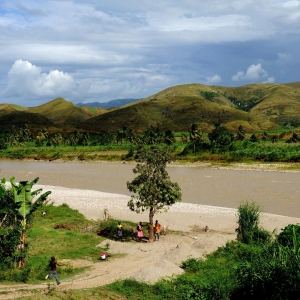The Stream, June 21, 2023: In Water-Scarce Gulf Coast City, Proposed Desalination Plants Put Oil Industry First, Residents Say

Though the pandemic slowed construction around the Corpus Christi port, a new steel factory, liquid natural gas processing plant, a chemical plant, and storage tanks require water. So much water the city is considering building two desalination plants to provide 94,000 acre-feet of water to industry. Photo © Brian Lehmann for Circle of Blue
YOUR GLOBAL RUNDOWN
- A new study finds that groundwater pumping over the past few decades has affected the tilt of the Earth.
- In Corpus Christi, Texas, residents are fighting proposed desalination plants which would prioritize water for companies, not residents or wildlife.
- The Chinese government is investing record amounts of money to engineer a “national water system.”
- Cyclone Biparjoy — which means “disaster” in Bengali — claims at least five lives as it makes landfall near the Pakistan-India border.
As floodwaters recede following the destruction of a dam in southeastern Ukraine, officials express concern over waterborne illnesses.
“Currently, trucks carrying essential medical supplies for infectious diseases such as cholera are being unloaded. As of today, we have not had any reported cases of illness, but we are actively preparing.” — Oleksandr Chebotarov, the medical director at the Kherson City Clinical Hospital.
Two weeks ago, the Kakhovka dam in southern Ukraine was struck and destroyed, triggering flooding that forced thousands of people to evacuate their homes while placing hundreds of thousands of residents and farmers at risk of running out of drinking water in the coming weeks.
The New York Times reports that Ukrainian officials are now also bracing for the spread of infectious, waterborne illnesses such as cholera. In downstream areas directly impacted by the flooding, where resources are limited, pollution has made the influx of water unsafe for bathing, swimming, fishing, and drinking, experts have warned.
And areas which flood waters didn’t reach are still at risk. “Household garbage, mines, plastic, branches and dead animals have been washing up along the city’s coastline after the dam disaster,” increasing residents’ risk of pathogens should they use this water.
Government officials have said that water quality tests for cholera have returned negative results, and that treatment facilities are in “emergency disinfection” mode.
In context: Cholera Cases Spike Amid Extreme Weather, Conflict
— Christian Thorsberg, Interim Stream Editor
Recent WaterNews from Circle of Blue
- Say Goodbye to Lawns in Drying U.S. West — Booming metro areas test the limits of water supply and growth.
- HOTSPOTS H2O: Citing Dire Risk to Water and Communities, Groups Oppose Newmont’s Gold Mine in Haiti — They assert that mining would harm watersheds and pollute already scarce water reserves.
The Lead
Between 60 and 80 percent of the water supply in Corpus Christi, Texas, is designated for industrial users — mainly oil and plastics corporations — Sierra Magazine reports.
These figures have been bolstered by recent city council votes, including a 2017 decision to allocate 20 million gallons of water per day to ExxonMobil and the Saudi Arabian firm SABIC, as well as a 2019 plan to “send an additional 55 million gallons per day to industrial facilities by 2030.” Backdropping these decisions, the city has declared multiple droughts and imposed water restrictions for residents.
To prepare for companies’ future water needs, the city has proposed building five desalination plants along Corpus Christi Bay. The facilities, which would collectively cost $2.6 billion, would convert tens of millions of gallons of saltwater into freshwater, daily. Not only would most of this water be used for industry, but the bay’s fisheries and coastal ecosystems would be devastated, Sierra reports.
Regional environmentalists are doing their best to oppose the projects because a decline in habitat health has local consequences. In Corpus Christi, where water is in short supply, not only would the plants prioritize industries that are actively polluting local communities, but marine economies would also suffer.
“This is a really ecologically sensitive and valuable area that is home to a lot of endangered species,” said Kristin Nielsen, an aquatic toxicologist and assistant professor at the University of Texas’s Marine Science Institute. “You have fish populations that support billions of dollars in revenue for the state of Texas. Redfish and sea trout alone account for two-thirds of that value. From a socioeconomic standpoint, you can imagine what would happen to local land values if the fishing were gone.”
This Week’s Top Water Stories, Told In Numbers
31
Inches that Earth’s rotational pole shifted between 1993 and 2010 due to humans pumping and redistributing groundwater around the globe, Yale 360 reports. According to the study, “Earth’s pole has drifted toward 64.16°E at a speed of 4.36 centimeters per year” during that 17-year timespan. This movement of more than 2 trillion tons of groundwater raised global sea levels by nearly a quarter of an inch, changing the “position of the Earth’s rotational pole — the point around which the planet spins.”
270,000
Number of people in India and Pakistan who were moved from vulnerable areas or evacuated ahead of Cyclone Biparjoy, which made landfall last week near the two countries’ border and moved inland through India’s west coast, the New York Times reports. The storm, “knocking out power in more than 4,000 villages, damaging roads and uprooting trees,” is responsible for at least five human deaths in India as floods swept through towns.
On the Radar
The Chinese government is planning a series of megaprojects to secure its water future amidst precipitation patterns wavering in a warming planet, Reuters reports. An expensive “national water network” including “new canals, reservoirs and storage facilities” would transform the country’s river systems to favor irrigation and resource distribution, though at the expense of riparian habitat, scientists warn.
Such infrastructural investments are already underway in China. Over the past five years, more than 100 diversion projects have been planned or broken ground. Last year, the government spent $154 billion on fixed water assets, and is on pace for even greater spending in 2023. Some of the most significant projects center on the Yangtze and Yellow rivers.
More Water News
Red Floods: Flooding near a nickel mine in Sulawesi, Indonesia has spread red waters across vast swaths of farmland, causing “longer harvest cycles and reduced productivity,” Mongabay reports.
St. John the Baptist Parish: Along the banks of the Mississippi River in Louisiana’s Cancer Alley, two sisters are fighting “to protect their community’s health and enslaved ancestors’ history,” The 19th reports.
Christian Thorsberg is an environmental writer from Chicago. He is passionate about climate and cultural phenomena that often appear slow or invisible, and he examines these themes in his journalism, poetry, and fiction.







Leave a Reply
Want to join the discussion?Feel free to contribute!